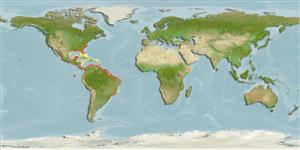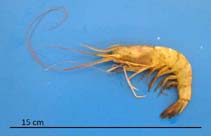Xiphopenaeus kroyeri (Heller, 1862)
Atlantic seabob| Native range | All suitable habitat | Point map | Year 2050 |

|
| This map was computer-generated and has not yet been reviewed. |
| Xiphopenaeus kroyeri AquaMaps Data sources: GBIF OBIS |
Classification / Names Populärnamn | synonymer | CoL | ITIS | WoRMS
Malacostraca | Decapoda | Penaeidae
Environment: milieu / climate zone / djupintervall / distribution range Ekologi
; brackvatten; djupintervall 0 - 70 m (Ref. 8), usually ? - 27 m (Ref. 8). Tropical; 17°C - 26°C (Ref. 132369), preferred 26°C (Ref. 107945); 36°N - 32°S, 109°W - 34°W
Distribution Länder | FAO områden | Ekosystem | Förekomster | Utplanteringar
Eastern Central Pacific, Western Atlantic and the Arctic: North Carolina to Gulf of Mexico, Caribbean to Brazil (Ref. 91956), and Mexico to Peru (Ref. 94212), Pacific South America. Tropical to polar.
Length at first maturity / Size / Weight / Age
Könsmognad: Lm 1.4, range 1 - 1.75 cm Max length : 17.0 cm TL hane/ej könsbestämd; (Ref. 8)
Life cycle and mating behavior Könsmognad | Reproduktion | Lek | Eggs | Fecundity | Larvae
Main reference
referenser | Koordinator | Medarbetare
Holthuis, L.B. 1980 FAO Species Catalogue. Vol. 1. Shrimps and prawns of the world. An annotated catalogue of species of interest to fisheries. FAO Fish. Synop. 125(1):271 p. Rome: FAO. (Ref. 8)
IUCN Red List Status
(Ref. 130435: Version 2025-1)
CITES status (Ref. 108899)
CMS (Ref. 116361)
Threat to humans
Human uses
Fiskeri: kommersiell
FAO - fiskeri: landings, species profile | FIRMS (Stock assessments) | FishSource | Sea Around Us
Verktyg
Ytterligare information
Max. ages / sizes
Length-weight rel.
Length-length rel.
Length-frequencies
Mass conversion
Abundans
Internet-källor
BHL | BOLD Systems | CISTI | DiscoverLife | FAO(fiskeri: species profile; publication : search) | Fishipedia | GenBank (genome, nucleotide) | GloBI | Gomexsi | Google Books | Google Scholar | Google | PubMed | Tree of Life | Wikipedia (Go, sök) | Zoological Record



